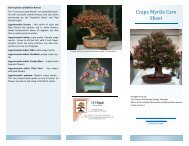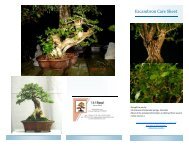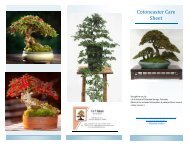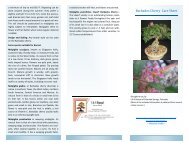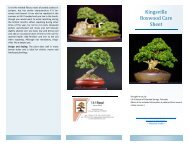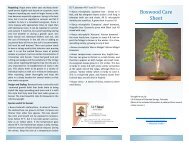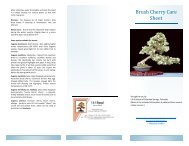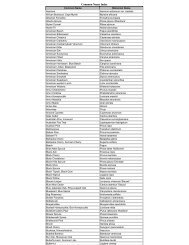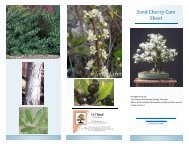Dwarf Pomegranate Care Sheet
Dwarf Pomegranate Care Sheet
Dwarf Pomegranate Care Sheet
- No tags were found...
Create successful ePaper yourself
Turn your PDF publications into a flip-book with our unique Google optimized e-Paper software.
<strong>Dwarf</strong> <strong>Pomegranate</strong><strong>Care</strong> <strong>Sheet</strong>Brought to you byS & S Bonsai of Colorado Springs, Colorado(Most of the included information is obtained from severalonline sources.)“Live as if you were to die tomorrow. Learn as ifyou were to live forever.”—Mahatma Gandhi—
The <strong>Dwarf</strong> <strong>Pomegranate</strong>(Punica granatum var. nana )General Information: <strong>Pomegranate</strong> trees havebeen cultivated since prehistoric times. In ancientEgypt and ancient Israel it was considered a sacredplant to be worshipped.The <strong>Dwarf</strong> <strong>Pomegranate</strong>, Punica granatum var.nana is a very popular and admired tree in bonsai- for both its fruiting and flowering qualities. Everyaspect of this form is dwarf compared to the basicpomegranate - from its overall size to its finerleaves and smaller flowers and fruits. Due to this,it is a plant especially recommended for miniaturebonsai and small styles. Apart from the pomegranate'sstunning seasonal yellow-orange or red'trumpet style' flowers, it presents so many othernotable characteristics. It has a marvelous naturally-twistingstyle trunk, that very easily adopts agnarled, ancient appearance - something widelysought in bonsai. Its leaves are a dark green withshades of bronze. After flowering, the plant fruits,producing attractive spherical-like red golf-ballsized pomegranates.CARETemperature: The tree is not hardy and needs tobe regarded as a greenhouse subject or, at thevery least, a plant that must be kept in frost-freeconditions. The plant may be overwintered at eithera cool or relatively warm temperature, 43°-50°F, or up to 64°F. The plant is best kept at temperaturesin the 70’s. With the warmer temperatures,however, the plant will grow less compact,and more spindly.Lighting: Place pomegranates in good light. Theylike sunlight, but must be kept watered. Theymust be protected from frost. Either all yearround indoors at a well ventilated southerly orwesterly window, or outside from late spring untilearly autumn in a sunny position; once the leaveshave fallen, bring back indoors again.Watering: Keep damp at all times. Before midseason,shade the tree slightly to conserve moisture.By keeping the pomegranate slightly dry inmid to late Spring, the tree is encouraged to setflowering shoots. A lot of water at this stage willinduce lush leaf shoots. After flowers appear, wateris given freely for the rest of the season. In winter,when it has shed its leaves, it needs only moderatewatering.<strong>Pomegranate</strong>s like water, so do not use pots thatare too shallow.Fertilizing: Feed when leaves swell until the floweringperiod, using half strength Miracle-Gro, or asimilar feed, alternately with 0-10-10 every 10days. After the flowering period, if there are anyfruit formed, recommence the feeding cycle butalso feed monthly until early autumn with fishemulsion. Do not feed in winter at all.Pruning / Training: The plant should be prunedhard before any new shoots emerge in Spring, tomake way for the new growth. Older branches canbe pruned in midseason. New shoots are pinchedfrom early summer, keeping between two and fiveleaves on each shoot, depending on the branch'sposition in the crown, once new shoots havereached a length of 6”. More mature trees can bepruned at an earlier stage.Flower buds are produced at this period, and earlierpruning can remove them. Flowering shoots areusually shorter than leaf shoots. Do not cut floweringshoots if it is flowers you want. Remember tocheck as you work: flowers are carried at the terminals.Repeat trimming as necessary. One- and twoyearold branches can be styled easily by wiring.Older branches will have to be guyed down.Wire in mid-season, using aluminum wire. All woodis brittle and breaks easily.Insects / Pests: Essentially trouble free, pomegranatesmay sometimes be affected by aphids.<strong>Pomegranate</strong>s kept indoors are often attacked bywhitefly. This pest is very difficult to control andcan best be eradicated by spraying down the treewith a strong jet of water (especially on the undersidesof the leaves) and then sprayed with a soapand water mixture. Whiteflies can be kept to aminimum by assuring that there is very good ventilationin the area. Outdoors, pomegranates arealso susceptible to greenfly infestation. Treat withpyrethrum or a similar insecticide.Propagation: The pomegranate is easily propagatedfrom cuttings and seed or by layering anddivision.Repotting: Repot in mid-spring when the buds areforming. Young trees are repotted every year.Older plants are repotted as indicated by root production,which means gently tapping the rootmass free of the pot and checking for areas of soilnot yet permeated with root. If there is still soilavailable, repotting is delayed for another season.Never use shallow containers when potting becausethis tree flowers well when slightly rootboundand it needs soil capacity and a reservoireffect to support it in this condition.Containers in quiet blues, yellows and unglazedbrowns and grays are suitable.Soil should consist of two parts sand, five partsmixed composted peat and leaf mould and threeparts Turface.Design and Styling: Suited to bonsai styles such asinformal upright, forest, cascade, literati, tree onrock, root over rock, twin trunk, windswept, groupand twisting trunk style




